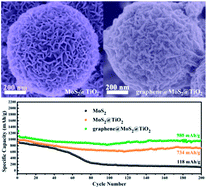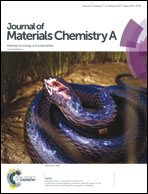Hybrid graphene@MoS2@TiO2 microspheres for use as a high performance negative electrode material for lithium ion batteries†
Abstract
A graphene@MoS2@TiO2 hybrid material was successfully prepared by a multi-step solution chemistry method. Few-layered MoS2 nanosheets were impregnated into the nanovoids of mesoporous TiO2 microspheres and the composite was further encapsulated by a graphene layer. When used as a negative electrode material for lithium ion batteries, the nanovoids of TiO2 reduced aggregation of MoS2 and suppressed the large volume change of the active material. Moreover, the dissolution and shuttle of polysulfides were effectively suppressed by the hybrid bonding between MoS2 and TiO2. The nano-sized MoS2 and TiO2 particles encapsulated by a high electronic conductive graphene layer improved the charge transfer reaction of the electrode. Due to these merits, the graphene@MoS2@TiO2 showed a large discharge capacity of 980 mA h g−1 at 0.1 A g−1 current density with a capacity retention of 89% after 200 cycles. Moreover, the material delivered 602 mA h g−1 at 2 A g−1 current density, much larger than 91 mA h g−1 for the pristine MoS2. This demonstrated that the hybrid graphene@MoS2@TiO2 microspheres have great potential as a high-performance negative electrode material for lithium ion batteries.



 Please wait while we load your content...
Please wait while we load your content...